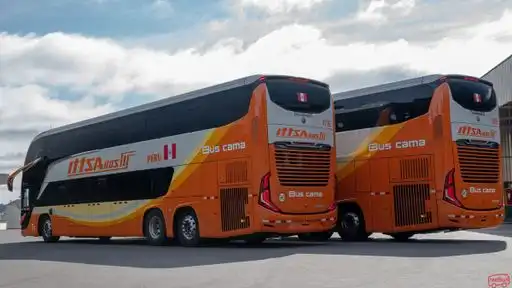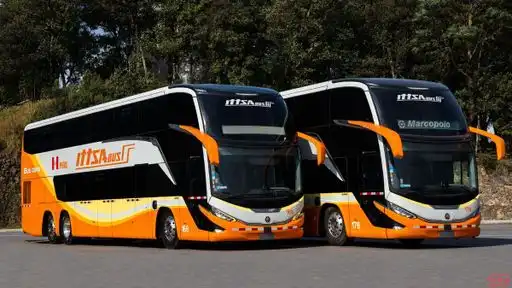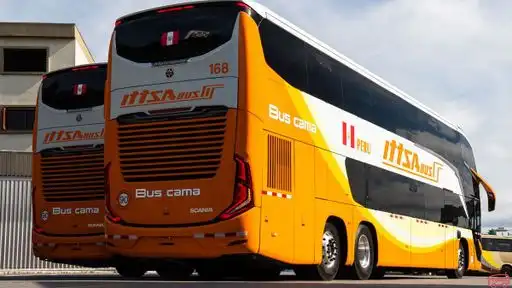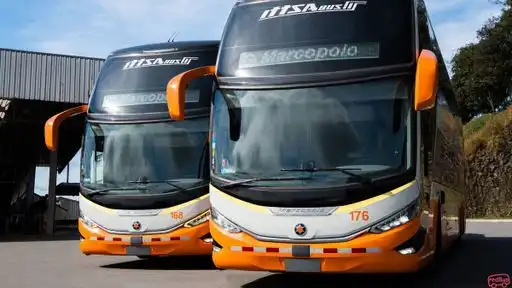Trujillo to Tumbes Bus
OUR PROMISE
SECURE PAYMENT
redBus has secure payments and keeps your information and purchases completely safe and secure.
ATTRACTIVE DEALS
Get amazing discounts every time you book with redBus
WIDE CHOICE OF BUSES
150+ Bus companies with 800+ Routes in Perú
Trujillo to Tumbes Bus Service
Avg. Bus Duration
:12 hrs 32 mins
Buses depart from
:Trujillo
Bus arrives in
:Tumbes
Cheapest Bus
:PEN 110.00
Bus Companies
:2
Earliest Bus
:16:30
Last Bus
:20:45
Daily Bus Services
:5
Trujillo to Tumbes Bus Timings & Fare
| Bus Operator | First Bus | Last Bus | Duration | |
|---|---|---|---|---|
| Tour Peru Vip | First Bus - 19:00 | Last Bus - 20:45 | 12 hrs 0 mins | VIEW PRICE |
| ITTSABUS | First Bus - 19:00 | Last Bus - 20:45 | 12 hrs 0 mins | VIEW PRICE |
Buy Trujillo to Tumbes Bus Tickets Online - Unlock Extra Savings with redDeals on redBus
Trujillo to Tumbes Bus
The travel from Trujillo to Tumbes is at a distance of 475 mi (764 km) and it takes about 11 hours on the highway. The transportation company Transportes Chiclayo, Primera Plus and ITTSABUS, covers this route, providing bus tickets at the low-cost of s/. 60 and s/. 70. The buses leave from the terminal of Av. Del Ejército in the central area of Trujillo city at 8:00 p.m., destination to the terminal of Av. Tumbes, main road of the central area of Tumbes. The climate in Tumbes is humid and semi-warm, tropical and with temperatures that average 80 °F (27 °C).

Top Bus Operator Images





OTHER BOARDING & DROPPING POINTS IN
Trujillo
- Av Del Ejercito
- Av Juan Pablo
Tumbes
- Terminal Tumbes
Why book a Trujillo to Tumbes bus with redBus?
You can also time-to-time redBus offers while booking your bus tickets online from Trujillo to Tumbes. Follow a simple, fast and secure bus booking procedure. This helps save time and also helps to create a joyful travel experience!
About Trujillo
Trujillo was founded in 1534 by Diego de Almagro, under the name “Villa of Truxillo”. With the passing of time Trujillo would consolidate as one of the most important cities of the Peruvian viceroyalty, for being an administrative and commercial center, essential for the colonial system. During the independence period, Trujillo had a relevant role on Peru’s Independence, what gave the surname of “Ciudad Benemérita y Fidelísima a la Patria” (“Meritorious city and Faithful to the Homeland”). Besides that, it was the first city to break free from Spain. During the 19th century, and later that the Moche and Chicama valleys emerged as settlements of the sugar industry and the economy grew, new residents came to the city; mostly were european immigrants, what contributed to the development of a local esthetic, since the constructions took breathing from the neoclassical style.
About Tumbes
Tumbes, founded on January 7, 1821, is located in the north of the country, quite close to Ecuador. It is one of the most requested tourist attractions on the Peruvian coast, with nearly 200,000 inhabitants within it. It has a lot of adrenaline and fun, as well as beaches, restaurants and delicious food.
Tumbes Weather
Tumbes usually has a warm climate, since, during the year, it has a temperature that oscillates between 21 °C and 31 °C.
Hotels in Tumbes
● Rizzo Plaza Hotel
- Jr. Bolognesi 216, Tumbes, Tumbes, Peru.
- Price: From PEN S/.218.00
- Services: Three-star hotel with rooms with warm lighting. It has Wi-fi and restaurant. It includes breakfast.
● Casa Cesar
- Huascar 311, Tumbes, Tumbes, Peru.
- Price: From PEN S/.180.00
- Services: Child-friendly three-star hotel. It has air conditioning, Wi-fi and spacious rooms.
● Hotel B´liam
- Alfonso Ugarte 309, Tumbes, Tumbes, Peru.
- Price: From PEN S/.180.00
- Services: Child-friendly three-star hotel. It has air conditioning, Wi-fi and breakfast.
Restaurants & Bars in Tumbes
● Marinus
- Av. Panamericana Norte, Km. 1197, Tumbes, Tumbes, Peru.
- Price: From PEN S/.25.00
● Acuarelas Cafe-Bar-Restaurant
- Av. Grau 401, Tumbes, Tumbes, Peru.
- Price: From PEN S/.30.00
● Bilbao Comida Fusion
- C. Bolognesi 422, Tumbes, Tumbes, Peru.
- Price: From PEN S/.45.00
Tourist Places in Tumbes
● Tumbes Main Square: Site that preserves local history, ideal for having an ice cream and walking with company.
● Tumbes Mangroves National Sanctuary: Area to appreciate the nature and landscapes of Tumbes.
● Crocodile Farm: A place to live with these animals and give them a welcoming visit.
Important Dates in Tumbes
● July 16th - The city of Tumbes pays homage to the patron saint, the Virgen del Carmen, through various activities.
How to move around Tumbes?
● Taxi: Private service cars that will take you wherever you want.
● Bus: The cheapest means of transportation, whose stops are at various points.
How to reach Tumbes from Trujillo?
The duration of the journey lasts approximately 11 hours, crossing 764 kilometers.
Gastronomy in Tumbes
What you must eat:
● Majariscos
● Arroz con conchas negras
● Tamalitos verdes
Things to buy in Tumbes
What you can buy to remember Tumbes:
● Handcraft
● Keychains
● Jewelry
Tumbes Facts
Tumbes, capital city of the department of the same name, is located in the north of Peru. It has almost 200,000 inhabitants, and was founded on January 7, 1821.
Bus Operators from Trujillo to Tumbes
- Transportes Chiclayo
- Primera Plus
- ITTSABUS
In conclusion:
To escape from the city and routine, Tumbes is your starting point. Pack your bags!
FAQs
How can I make an online bus ticket booking in Peru?
How do I book a bus from Trujillo to Tumbes?
Do I need to print out my bus ticket before boarding?
Can I reschedule my journey after I have booked my ticket?
How do I pay for my bus ticket on the redBus website?
How much does the bus fare from Trujillo to Tumbes cost?
In redBus, the ticket from Trujillo to Tumbes starts from S/75.00. These prices vary according to the season, transportation company, and service.
How long does it take to travel from Trujillo to Tumbes by bus?
The bus journey from Trujillo to Tumbes takes approximately 12 hours.
Which agencies operate from Trujillo to Tumbes?
The main agencies covering the Trujillo-Tumbes route are: Transportes Chiclayo, Primera Plus and ITTSABUS.